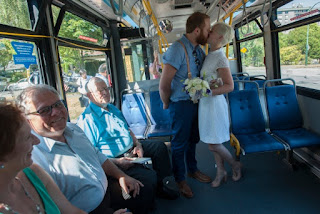Transit stories
 Nina Schmidt and Jarred Greff get married on a Coast Mountain transit bus in Vancouver, BC, August 6, 2013. They first met on the #3 bus on Main street. ARLEN REDEKOP / PROVINCE
Nina Schmidt and Jarred Greff get married on a Coast Mountain transit bus in Vancouver, BC, August 6, 2013. They first met on the #3 bus on Main street. ARLEN REDEKOP / PROVINCE1. Couple meets on the bus, later they marry ("Match: A chance bus encounter left him speechless," Toronto Globe & Mail) with a special ceremony on the bus ("Couple take the ride of their life by saying ‘I do’ on Vancouver bus," Vancouver Province).
Of course, it took a few requests before the transit agency agreed to use of the bus for the wedding.
 Political science junior Ryan Wadding, a Marine Corps veteran, was frustrated with the hassles of driving and parking at ASU so he started taking the light rail and busses with the U-Pass. With no need for a car, he sold it. Photo by Charlie Leight/ASU Now
Political science junior Ryan Wadding, a Marine Corps veteran, was frustrated with the hassles of driving and parking at ASU so he started taking the light rail and busses with the U-Pass. With no need for a car, he sold it. Photo by Charlie Leight/ASU Now2. Ryan Wadding, a student at Arizona State Universit, after experiencing the ease of using transit in Germany, decided to sell his car upon returning to the US ("ASU student liked public transit so much he sold his car," ASU Now). It happens the campus is near the Tempe Transportation Center, which is a stop on the ValleyLink light rail system, and a local and regional bus transit center. From the article:
“I was using my car to commute and parking in a structure. I paid $720 to park per academic year,” he said. “I also paid for gas, vehicle insurance, registration costs and regular maintenance.”The cost of an annual transit pass for students is $200 which includes all Valley Transit services including light rail and commuter buses.
In Munich last summer, Wadding saw how simple and enjoyable public transit and walking can be. Public transportation is less stressful, more sustainable and gives you an opportunity to get some work done, he said.
He now uses a U-Pass, the light rail and the intercampus shuttle to get to campus.
“Many times (on public transit), I saw things I knew I would have missed in a car. I observed people I rode with and saw into the culture of wherever I was,” Wadding said.


0 Comments:
Post a Comment
<< Home